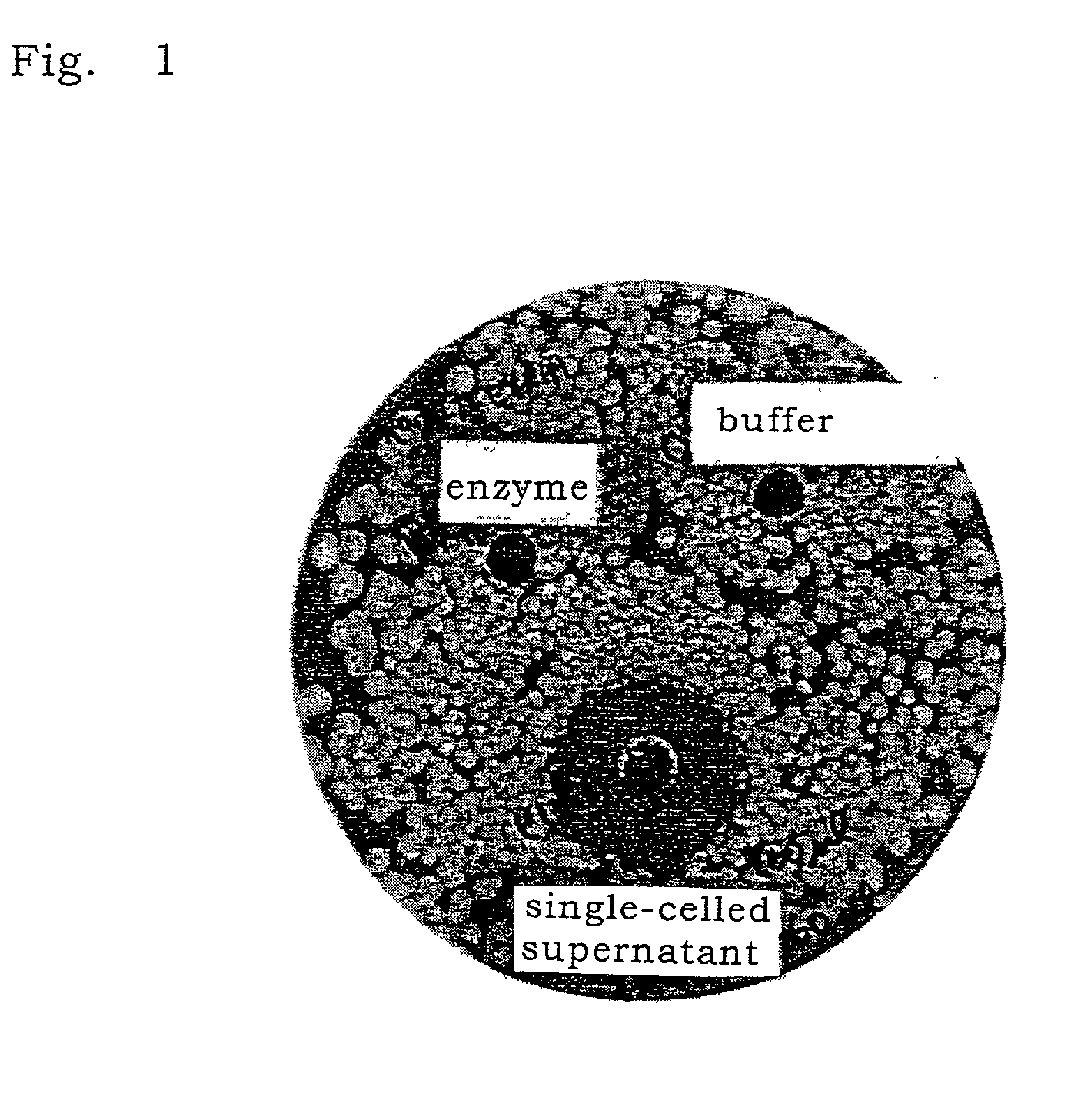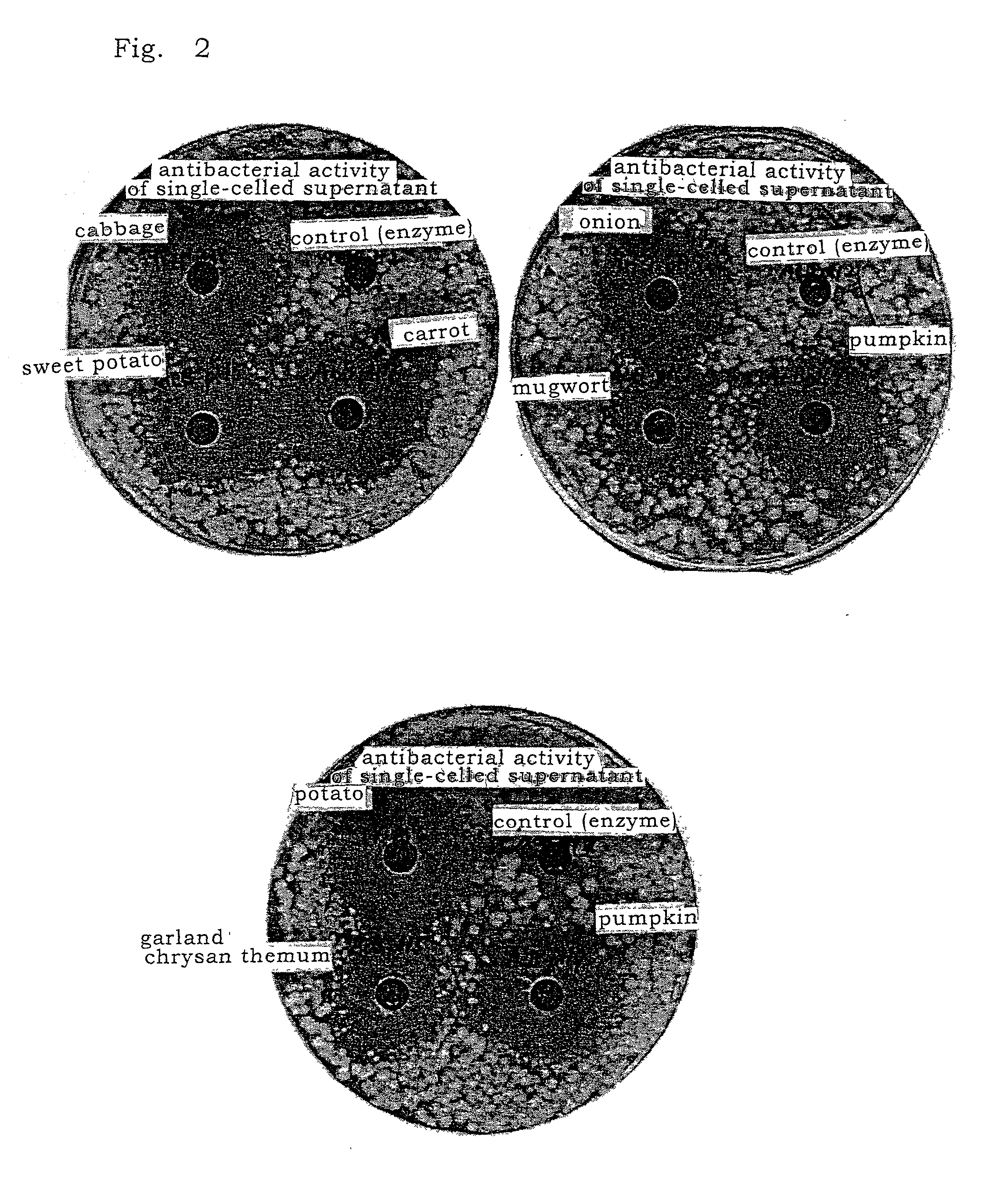Process for producing plant-origin antibacterial substance
a technology of antibacterial substance and plant origin, which is applied in the directions of plant/algae/fungi/lichens ingredients, biocide, unknown materials, etc., can solve the problems of easy proliferation of bacteria, large economic damage, contamination of food, etc., and achieve the effect of easy decomposition
- Summary
- Abstract
- Description
- Claims
- Application Information
AI Technical Summary
Benefits of technology
Problems solved by technology
Method used
Image
Examples
example 2
[0035] Various species of plants weighting 3 g chopped into pieces of 0.5 to 1 cm square were suspended in 10 mL of 100 mM acetate buffer pH 7 containing protopectinase-S (500 units). The resulting suspensions were stirred at 37.degree. C. for an hour and then were centrifuged in the manner described in Example 1. The antibacterial activity of the supernatants against Bacillus subtilis was determined in the same manner as described in Example 1. The antibacterial activity was recognized with all the plants as shown in Table 2.
2 TABLE 2 Plants used (parts) Antibacterial Activity (unit / mL) Sweet potato (root) 47.0 Pumpkin (fruit) 49.3 Cabbage 61.2 (terrestrial stem and leaves) Garland chrysanthemum 34.0 (terrestrial stem and leaves) Carrot (root) 60.2 Potato (subterranean stem) 61.2 Onion (subterranean stem) 44.2 Mugwort 34.0 (terrestrial stem and leaves) Dandelion 18.1 (terrestrial stem and leaves) Dropwort 22.5 (terrestrial stem and leaves) Cotton (flowers) 11.5 Control (enzyme alon...
example 3
[0037] Various species of plants (parts used were the same as in Example 2) were chopped into pieces of 1 to 2 cm square and suspended in 100 mM acetate buffer pH 7, and then were completely ground at 5.degree. C. using a Waring blender. The supernatants obtained by removing insoluble substances by centrifugation were tested for their antibacterial activity against bacillus subtilis in the same manner as in Example 1.
[0038] The results show that the plants had the antibacterial activity as shown in Table 3.
3 TABLE 3 Plants used Antibacterial Activity (unit / mL) Sweet potato 7.0 Pumpkin 5.3 Cabbage 11.2 Garland chrysanthemum 13.0 Carrot 6.5 Potato 7.3 Onion 34.2 Mugwort 24.2 Control (enzyme alone) 0
[0039] Thus, it was proved that not only liquids obtained by disintegrating plant tissue with enzymes but also liquids of ground plants obtained by mechanical technique contained antibacterial substances.
example 4
[0040] The activity of liquids containing antibacterial substances prepared from a pumpkin (fruit) and a sweet potato (root) according to the process of Example 1 using protopectinase-S were determined with regard to the microorganisms shown in Table 4.
4 TABLE 4 Antibacterial activity (Activity of sweet potato extract against Bacillus subtilis is assumed to be 100 Microorganisms Sweet potato ex. Pumpkin ex. Bacillus subtilis 100 290 IFO 3134 Bacillus cereus 113 283 IFO 3001 Bacillus alvei 110 300 IFO 14175 Bacillus sphaericus 98 267 IFO 3528 Bacillus pumilus 132 301 IFO 3030 Bacillus megaterium 121 305 AKU 212 Bacillus 30 51 amyloliquefacienece IFO 14141 Bacillus circulans 32 48 IFO 33239 Bacillus coagulans 30 56 IFO 12583 Bacillus firms 38 55 IFO 3330 Bacillus licheniformis 28 42 IFO 14206 Bacillus macerance 42 68 IFO 3490 Bacillus natto 56 80 IFO 3013 Clostridium 81 230 acetobutylicum ATCC 3625 Aspergillus awamori 11 25 IFO 4033
[0041] Table 4 clearly shows that the antibacterial s...
PUM
| Property | Measurement | Unit |
|---|---|---|
| pH | aaaaa | aaaaa |
| size | aaaaa | aaaaa |
| wet weight | aaaaa | aaaaa |
Abstract
Description
Claims
Application Information
 Login to View More
Login to View More - R&D
- Intellectual Property
- Life Sciences
- Materials
- Tech Scout
- Unparalleled Data Quality
- Higher Quality Content
- 60% Fewer Hallucinations
Browse by: Latest US Patents, China's latest patents, Technical Efficacy Thesaurus, Application Domain, Technology Topic, Popular Technical Reports.
© 2025 PatSnap. All rights reserved.Legal|Privacy policy|Modern Slavery Act Transparency Statement|Sitemap|About US| Contact US: help@patsnap.com


